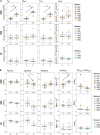Non-invasive tape sampling of tryptophan and kynurenine in relation to phenylalanine and tyrosine from melanoma and adjacent non-lesional skin: A pilot study
- PMID: 40554511
- PMCID: PMC12186910
- DOI: 10.1371/journal.pone.0326457
Non-invasive tape sampling of tryptophan and kynurenine in relation to phenylalanine and tyrosine from melanoma and adjacent non-lesional skin: A pilot study
Abstract
Purpose: To evade immunosurveillance many cancers convert tryptophan (Trp) into kynurenine (Kyn), which induces immunotolerance and suppresses immune responses. Elevated Kyn amounts have been found in blood from patients with cutaneous melanoma. This study aimed to investigate whether higher Kyn abundance and lower Trp abundance can be detected on the surface of cutaneous melanoma lesions compared with adjacent non-lesional skin.
Methods: Sixteen patients with suspected melanomas were enrolled in this study. All lesions were excised and histopathologically diagnosed: 7 lesions were diagnosed as invasive malignant melanomas (MM), 6 as melanomas in situ (MIS), and 3 as benign lesions (BL). Non-invasive metabolite sampling was performed by tape stripping of suspected skin lesions and adjacent healthy non-lesional (NL) skin. Trp, Kyn, tyrosine (Tyr), and phenylalanine (Phe) were quantified by liquid chromatography-tandem mass spectrometry (LC-MS/MS). Electrical impedance spectroscopy (EIS) measurements were conducted to assess skin barrier integrity.
Results: Levels of all metabolites, Tyr (x6), Phe (x6), Trp (x5), and Kyn (x3), were significantly higher in MM lesions compared with adjacent NL skin, resulting in an elevated Trp/Kyn ratio. Trp levels increased less than Phe and Tyr levels, suggesting a potential increase in Trp depletion. Skin resistance in MM lesions was half that of NL skin. No differences were observed between MIS or BL and NL skin.
Conclusions: Non-invasive skin sampling revealed elevated Tyr, Phe, Trp and Kyn levels in MM skin, which is likely the result of compromised skin barrier at this stage of cutaneous melanoma.
Copyright: © 2025 Jankovskaja et al. This is an open access article distributed under the terms of the Creative Commons Attribution License, which permits unrestricted use, distribution, and reproduction in any medium, provided the original author and source are credited.
Conflict of interest statement
The authors have declared no competing interests exist.
Figures







Similar articles
-
Serum tryptophan-kynurenine metabolites served as biomarkers of disease activity in rheumatoid arthritis and linked to immune imbalance.Arthritis Res Ther. 2025 Jul 5;27(1):136. doi: 10.1186/s13075-025-03596-7. Arthritis Res Ther. 2025. PMID: 40618074 Free PMC article.
-
Altered neopterin and IDO in kynurenine metabolism based on LC-MS/MS metabolomics study: Novel therapeutic checkpoints for type 2 diabetes mellitus.Clin Chim Acta. 2024 Apr 15;557:117859. doi: 10.1016/j.cca.2024.117859. Epub 2024 Mar 20. Clin Chim Acta. 2024. PMID: 38518968
-
Systemic pharmacological treatments for chronic plaque psoriasis: a network meta-analysis.Cochrane Database Syst Rev. 2021 Apr 19;4(4):CD011535. doi: 10.1002/14651858.CD011535.pub4. Cochrane Database Syst Rev. 2021. Update in: Cochrane Database Syst Rev. 2022 May 23;5:CD011535. doi: 10.1002/14651858.CD011535.pub5. PMID: 33871055 Free PMC article. Updated.
-
Incidence, stage and outcome of malignant melanoma, keratinocyte and other cancers in individuals with vitiligo or alopecia: intraindividual or familial risks?Br J Dermatol. 2025 Jun 20;193(1):66-73. doi: 10.1093/bjd/ljaf074. Br J Dermatol. 2025. PMID: 39999038
-
Systemic pharmacological treatments for chronic plaque psoriasis: a network meta-analysis.Cochrane Database Syst Rev. 2017 Dec 22;12(12):CD011535. doi: 10.1002/14651858.CD011535.pub2. Cochrane Database Syst Rev. 2017. Update in: Cochrane Database Syst Rev. 2020 Jan 9;1:CD011535. doi: 10.1002/14651858.CD011535.pub3. PMID: 29271481 Free PMC article. Updated.
References
-
- World Health Organization (WHO). Ultraviolet (UV) radiation and skin cancer. 2017. [cited 17 Feb 2025]. https://www.who.int/news-room/questions-and-answers/item/radiation-ultra...
MeSH terms
Substances
LinkOut - more resources
Full Text Sources
Medical

